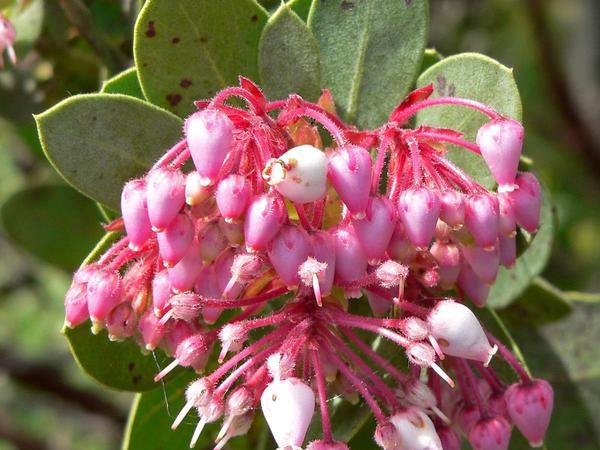Sandmat manzanita
(Arctostaphylos pumila)

Description
Arctostaphylos pumila, with the common name sandmat manzanita, is a species of manzanita. Arctostaphylos pumila is a petite, low-lying manzanita which forms flat bushes and patchy, creeping mats in sandy soil. The bark is reddish and tends not to shred. The leaves are small and mainly oval-shaped, dark green on the upper surface and grayish and fuzzy beneath. The flowers appear in sparse inflorescences and are white to very pale pink. The fruit is a round brownish drupe about half a centimeter wide. The Arctostaphylos pumila shrub is endemic to California where it grows on the coastline near Monterey and the Monterey Bay. Arctostaphylos is a genus of plants comprising the manzanitas and bearberries. They are shrubs or small trees. There are about 60 species, of Arctostaphylos, ranging from ground-hugging arctic, coastal, and mountain species to small trees up to 6 m tall. Most are evergreen (one species deciduous), with small oval leaves 1–7 cm long, arranged spirally on the stems. The flowers are bell-shaped, white or pale pink, and borne in small clusters of 2–20 together; flowering is in the spring. The fruit are small berries, ripening in the summer or autumn. The berries of some species are edible. Arctostaphylos species are used as food plants by the larvae of some Lepidoptera species including Coleophora arctostaphyli (which feeds exclusively on A. uva-ursi) and Coleophora glaucella. Manzanitas, the bulk of Arctostaphylos species, are present in the chaparral biome of western North America, where they occur from southern British Columbia in Canada, Washington to California and New Mexico in the United States, and throughout much of northern and central Mexico. Three species, the bearberries, A. alpina (alpine bearberry), A. rubra (red bearberry) and A. uva-ursi (common bearberry), have adapted to arctic and subarctic climates, and have a circumpolar distribution in northern North America, Asia and Europe. An unusual association of manzanita occurs on Hood Mountain, in Sonoma County, California, where stands of pygmy forest dominated by Mendocino cypress are found.
Taxonomic tree:







